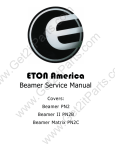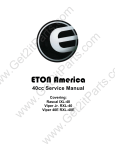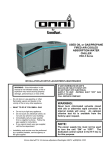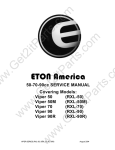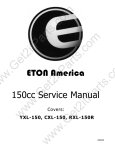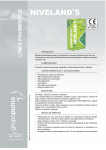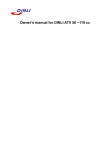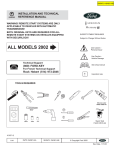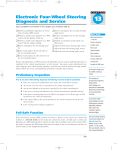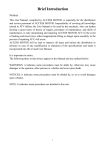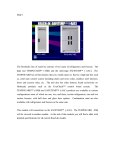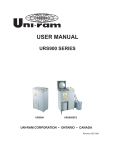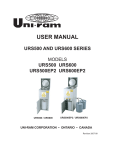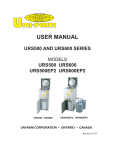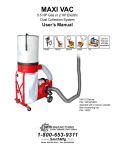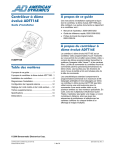Download Sierra DXL-90 - Get 2 It Sales, LLC
Transcript
om rts .c om tP ar ts .c ar ts .c tP a 2i w .G et 2i ETON America .G et w Sierra DXL-90 w 2i tP .G et w w Service Manual w w Rev 2.0.0 w Spartanburg, SC 29303 06/30/2000 w w .G et w ar ts .c 2i tP rts .c om tP ar ts .c 2i .G et tP a 2i .G et w w w w w om om .G et 2i tP 2i .G et w w w w w w ar ts .c tP a .G et w w Page 5 9 16 17 21 23 28 33 45 51 54 58 rts .c om Table of Contents INFORMATION MAINTENANCE ENGINE REMOVAL AND INSTALLATION ENGINE FUEL SYSTEM ENGINE LUBRICATION AND COOLING SYSTEM ENGINE COMBUSTION SYSTEM TRANSMISSION SYSTEM FRONT WHEEL AND STEERING SYSTEM REAR WHEEL SYSTEM FENDERS AND EXHAUST PIPE ELECTRICAL SYSTEM TROUBLE SHOOTING 2i Section 1. 2. 3. 4. 5. 6. 7. 8. 9. 10. 11. 12. tP ar ts .c TABLE OF CONTENTS w w .G et w ar ts .c 2i tP rts .c om tP ar ts .c 2i .G et tP a 2i .G et w w w w w om om 1. INFORMATION tP ar ts .c 1.1 SAFETY INFORMATION Gasoline is extremely flammable and is explosive under certain condition. Do not smoke or allow sparks or flames in your work area. rts .c om Never run the engine in a closed area. The exhaust contains poisonous carbon monoxide gas that may cause loss of consciousness and lead to death. The battery electrolyte contains sulfuric acid. Protect your eyes, skin and clothing. If you contact it, flush thoroughly with water and call a doctor if electrolyte gets in your eyes. 2i 1.2 NOTES w w w w .G et w w ar ts .c 2i tP .G et w 2i w tP a .G et All information, illustrations, directions and specifications included in this publication are base on the latest product information available at the time of approval for printing. E-TON Dynamic Technology Industry Co., Ltd. reserves the right to make changes at any time without notice and without incurring any obligation whatever. No part of this publication may be reproduced without written permission. 1-1 om tP ar ts .c 1.3 SPECIFICATION tP a 2i .G et 2i tP Dual Arm Swing Arm Drum Drum w w BRAKES Front Rear 1,510mm(59.4inch) 860mm(39.3inch) 950mm(37.4inch) 630mm(24.8inch) 1040mm(40.9inch) 130mm(5.1inch) 102kg 4.0liter TIRES Front Rear ar ts .c 2i .G et w .G et 19" x 7" - 8" 19" x 7" - 8” w Light Green / Green White / Red w w COLORING ***Specifications subject to change without notice. w w CHASSIS Overall Overall Width Overall Height Seat Height Wheel base Ground Clearance 85kg/95kg Fuel Tank Capacity Air-Cooling 2-Stroke DXL-90 - 82.5cc 50.0 x 42.0mm 5.8:1 7.2 N-m@6000rpm Mikuni VM16 Capacitor Discharge Electric Oil Pump Separate Supply 1. 0 liter Automatic (C.V.T V-belt) rts .c om ENGINE Type Displacement Bore and Stroke Compression Maximum Torque Carburetor Ignition Starting Lubrication Oil Capacity Transmission SUSPENSION Front Rear INFORMATION 1-2 om 1.4 SERIAL NUMBER INFORMATION tP a .G et 2i rts .c om tP ar ts .c The frame serial number is stamped on the front of the frame. The engine serial number is stamped on the left side of the crankcase. .G et w w Engine serial number w w w w ar ts .c 2i tP .G et w 2i w Frame serial number 1-3 om 2i FRAME Handlebar upper holder bolt Steering shaft nut Steering shaft bushing holder nut Wheel rim bolt Tie rod lock nut King pin nut Handlebar lower holder nut Front wheel bolt Front axle nut Front brake arm nut Rear brake arm nut Rear axle nut Rear wheel bolt Exhaust muffler mounting bolt Engine hanger bolt 24-30 N.m (17.7-22.1 lb./ft) 50-60 N.m (36.9-44.3 lb./ft) 24-30 N.m (17.7-22.1 lb./ft) 18-25 N.m (13.3-18.4 lb./ft) 35-43 N.m (25.8-31.7 lb./ft) 30-40 N.m (22.1-29.5 lb./ft) 40-48 N.m (29.5-35.4 lb./ft) 24-30 N.m (17.7-22.1 lb./ft) 55-65 N.m (40.6-47.9 lb./ft) 4-7 N.m ( 3.0- 5.2 lb./ft) 7-12 N.m ( 5.2- 8.9 lb./ft) 60-80 N.m (44.3-59.0 lb./ft) 24-30 N.m (17.7-22.1 lb./ft) 30-35 N.m (22.1-25.8 lb./ft) 24-30 N.m (17.7-22.1 lb./ft) w w w w .G et w w 2i tP .G et 2i tP a .G et w w 28-30 N.m (20.7-22.1 lb./ft) 12-19 N.m (8.9-14.0 lb./ft) 20-30 N.m (14.8-22.1 lb./ft) 8-12 N.m (5.9- 8.9 lb./ft) rts .c om tP ar ts .c ENGINE Cylinder head nut Spark plug Cylinder head bolt Alternator bolt ar ts .c 1.5 TORQUE VALUES INFORMATION 1-4 om 2. MAINTENANCE 2i .G et tP a 2.1 MAINTENANCE DATA SPECIFICATION THROTTLE LEVER FREE PLAY: IDLE SPEED: BRAKE LEVER FREE PLAY: DRIVE CHAIN SLACK FRONT/REAR TIRE SIZE FRONT/REAR TIRE PRESSURE TOE-IN 5-10 mm 1800±100 rpm 15-25 mm 10-25 mm 19X7-8 / 19X7-8 2.2± 0.3 psi(0.15 kgf/cm2) 5±10 mm TORQUE VALUES SPARK PLUG TIE-ROD LOCK NUT 12-19 N.m 35-43 N.m 2i tP w .G et w w JASO FC Grade or same degree oil SAE 40 w w w ENGINE OIL GEAR LUBRICATION OIL ar ts .c 0.6-0.7 mm NGK BPR7HS 2i SPARK PLUG: PARK PLUG GAP: RECOMMENDED SPARK PLUGS: .G et w w rts .c om tP ar ts .c 2.1 MAINTENANCE DATA 2.2 MAINTENANCE SCHEDULE 2.3 FUEL TUBE 2.4 THROTTLE OPERATION 2.5 THROTTLE CABLE ADJUSTMENT 2.6 AIR CLEANER 2.7 SPARK PLUG 2.8 IDLE SPEED 2.9 DRIVE CHAIN 2.10 BRAKE SYSTEM 2.11 WHEELS AND TIRES 2.12 STEERING SYSTEM 2.13 TOE-IN 2.14 GEAR OIL MAINTENANCE 2-1 tP ar ts .c The maintenance intervals in the follow table is based upon average riding, conditions. Riding in unusually dusty areas, require more frequent servicing INITIAL SERVICE (First week) REGULAR SERVICE (Every 30 operating days) 2i .G et 2.3 FUEL TUBE w 2.4 THROTTLE OPERATION w w w w .G et Inspect for smooth throttle lever full opening and automatic full closing in all steering positions. Inspect if there is no deterioration, damage or kinking in the throttle cable, replace it if necessary. Check the throttle lever, free play is 5-10 mm at the tip of the throttle lever. Disconnect the throttle cable at the upper end. Lubricate the cable with commercially lubricant to prevent premature wear. 2-2 I I I R 2i tP w Inspect the fuel lines for deterioration, damage or leakage and replace if necessary. EVERY Year I ar ts .c tP a .G et 2i rts .c om FUEL LINE THROTTLE OPERATION I I AIR CLEANER C SPARK PLUG I CARBURETOR IDLE SPEED I I DRIVE CHAIN I, L I, L BRAKE SHOE WEAR BRAKE SYSTEM I I NUT, BOLT, FASTENER I I WHEEL I I STEERING SYSTEM SUSPENSION SYSTEM C.V.T. AIR FILTER C GEAR OIL Note - I: Inspect and Clean, Adjust, Lubricate or Replace, if necessary C: Clean L: Lubricate R: Replace w w om 2.2 MAINTENANCE SCHEDULE MAINTENANCE om 2.5 THROTTLE CABLE ADJUSTMENT tP a .G et 2i Unscrew the air cleaner cover screws. Pull out the air filter element from the air cleaner case. Wash the element in non-flammable solvent, squeeze out the solvent thoroughly. Let it dry. Soak the filter element in gear oil and then squeeze out the excess oil. Install the element into air cleaner carefully. w .G et w w .G et This spark plug located at the front of the engine. Disconnect the spark plug cap and unscrew the spark plug. Check the spark plug electrodes for wear. Change a new spark plug if the electrodes and insulator tip appear unusually fouled or burned. Discard the spark plug if there is apparent wear or if the insulator is cracked or chipped. The spark plug gap shall keep in 0.6-0.7mm. With the sealing washer attached, thread the spark plug in by hand to prevent cross threading. Tighten the spark plug with 12-19 N.m 2i tP 2i 2.7 SPARK PLUG 2.8 IDLE SPEED w w w Connect a engine speed meter. Warm up the engine, 10 minutes are enough. Turn the idle-speed adjust screw on the carburetor to obtain the idle speed. "Turn in" (clockwise) will get higher speed. "Turn out" (counter clockwise) will get lower speed. IDLE SPEED: 1800±100 rpm 2-3 ar ts .c 2.6 AIR CLEANER rts .c om tP ar ts .c Slide the rubber cap of the adjuster off the throttle Housing, loosen the lock nut and adjust the free play of the throttle lever by turning the adjuster on the throttle housing. Inspect the free play of the throttle lever. w w MAINTENANCE om 2.9 DRIVE CHAIN tP ar ts .c Inspect the chain slack. The standard is 5-15mm. Clean the drive chain with kerosene and wipe it dry. Inspect the drive chain for possible wear or damage. Replace the chain, if it is worn excessively or damaged. 2i .G et w w w w .G et w w 2i tP Inspect the sprocket teeth. If it is excessive wear or damage, replace it. ar ts .c tP a .G et When the drive chain becomes very dirty, it should be removed, cleaned and lubricated by specify lubricator. Using commercial chain lubricant to lubricate the drive chain. 5 - 15mm rts .c om 2i Adjust the chain slack. Loose the lock bolts (4) then adjust the drive chain slack by turn the adjusting nut. Tighten the four lock bolts. w w MAINTENANCE 2-4 om 2.10 BRAKE SYSTEM 2i .G et w 2.11 WHEELS AND TIRES 2.12 STEERING SYSTEM w w .G et w Inspect the tire surfaces for cuts, nails or other sharp objects. Check the tire pressure at cold tire condition. The standard of tire pressure is 2.2±0.3 psi. ( 015 kgf/cm2 ) 2i tP Adjust the free play of the rear brake lever by turning the adjuster on the rear axle. w w Check the free play of the steering shaft with the front wheels, turned straight ahead. When there is excessive play, inspect the tie-rod, kingpin bushing and ball joint. 2-5 ar ts .c tP a .G et Inspect the rear rake lever and cable for excessive play or other damage. Replace or repair if necessary. Measure the free play of the rear brake lever at the end of the lever. The standard is 15-25 mm. rts .c om 2i tP ar ts .c Inspect the front brake lever and cable for excessive play or other damage. Replace or repair if necessary. Measure the free play of the brake lever at the end of the brake lever. The standard of free play is 15-25 mm. w w MAINTENANCE om 2.13 TOE-IN 2i w w w w .G et w w 2i tP .G et If the toe-in is out of standard, adjust it by changing the length of the tie-rods equally by turning the tierod while holding the ball joint. Tighten the lock nuts. Torque: 35-43 N.m ar ts .c tP a .G et 2i Carefully move the vehicle back, let the wheels have turned 180 °, so the marks on the tires are aligned with the axle center height. Measure the distance between the marks. Calculate the difference in the front and rear measurements. Toe-in: 5±10mm rts .c om tP ar ts .c Let the vehicle on level ground and the front wheels facing straight ahead. Mark the centers of the tires to indicate the axle center height. Measure the distance between the marks. w w MAINTENANCE 2-6 om w w w w .G et w w ar ts .c 2i tP .G et w 2i w tP a .G et 2i Gear oil needs to be changed every year. There is a gear oil release bolt at the rear of engine. Unscrew this release bolt and can let the dirty oil flow out. The re-add oil hole is on the engine case beside gear box. rts .c om tP ar ts .c 2.14 GEAR OIL MAINTENANCE 2-7 tP ar ts .c 3.1 ENGINE SHOULD NOT BE REMOVED UNLESS IT IS NECESsARY TO REPAIR OR MAKE ADJUSTMENTS TO THE TRANSMISSION AND/OR COMBUSTION SYSTEM! Disconnect the wire connectors. There are three connectors for carburetor auto-choke, starter motor and generator respectively. Remove the drive chain cover. This is under the chain. Remove the drive chain retaining clip and master link, and remove the drive chain. Remove the three engine hanger nuts and bolts. Remove the engine from the right side of frame. 2i 2i tP .G et w .G et w 3.3 ENGINE INSTALLATION Engine installation is essentially the reverse order of removal. The torque of engine hanger bolt is 24-30 Nm Route the wires and cable in reverse order properly. w w w w ar ts .c tP a .G et 2i Remove the seat and rear fender. (See chapter 10) Remove the spark plug cap from the spark plug. Remove the exhaust pipe. Disconnect the carburetor cable by unscrew two screws on top of the carburetor. Take off oil pump cable from the oil pump control plate. Oil pump is under the right side of engine. rts .c om 3.2 ENGINE REMOVAL w w ENGINE om 3. ENGINE REMOVAL AND INSTALLATION 3-1 ENGINE FUEL SYSTEM om 4. ENGINE FUEL SYSTEM tP ar ts .c 4.1 TROUBLESHOOTING NO FUEL IN TANK NO FUEL TO CYLINDER TOO MUCH FUEL GO INTO CYLINDER NO SPARK AT PLUG AIR CLEANER CLOGGED ENGINE IDLES ROUGH, STALLS OR RUNS POORLY IMPROPER ADJUSTMENT TO IDLE SPEED SCREW IGNITION MALFUNCTION FUEL/AIR MIXTURE RATIO NO GOOD AIR CLEANER DIRTY INSULATOR LEAKS FUEL TANK CAP BREATHING HOLE CLOGGED .G et 2i rts .c om ENGINE CAN NOT START w 2i FLOAT NEEDLE VALVE IN CARBURETOR FAULTY FLOAT LEVEL TOO HIGH AIR DUCT IN CARBURETOR IS CLOGGED AIR CLEANER DIRTY 2i tP .G et w RICH MIXTURE ar ts .c FUEL JET OF CARBURETOR CLOGGED FUEL TANK CAP BREATHING HOLE CLOGGED FUEL FILTER CLOGGED FUEL FLOWS IN THE TUBE ROUGHLY FLOAT LEVEL IN CARBURETOR TOO LOW tP a LEAN MIXTURE w w REMOVAL Remove the seat and rear fender. Disconnect the fuel line from the carburetor. Remove the fuel tank cap and front fender. Unscrew the fuel tank fixed bolts. .G et w 4.2 FUEL TANK w w w Note: Keep gasoline away from flames or sparks. Wipe up spilled gasoline at once. 4-1 om ENGINE FUEL SYSTEM 4.3 CARBURETOR tP a .G et 2i Remove the carburetor cap. Remove the throttle cable from the throttle valve while depressing the throttle valve spring. .G et w w 2i tP .G et 2i Remove the needle clip retainer, the jet needle and needle clip. Inspect the throttle valve and jet needle surface for wear., scratches or dirt. w DISASSEMBLY w w Unscrew the float chamber screws and remove the float chamber. w ar ts .c Note: Turn fuel cup on (off) position w w rts .c om tP ar ts .c REMOVAL Remove the air cleaner. Disconnect the fuel line and auto-choke electric wire. Unscrew the intake pipe mounting bolts at the carburetor then remove the carburetor. 4-2 om ENGINE FUEL SYSTEM .G et w w 2i tP .G et Clean all parts in solvent and blow it dry with compressed air. Assembly is essentially the reverse order of disassembly. THROTTLE VALVE ASSEMBLY w w Install the needle clip on the jet needle. Install the jet needle into the throttle valve. Assemble the throttle cable, spring and the throttle valve. Align the throttle valve groove with the idle speed adjust screw and install the carburetor cap to the carburetor. w ar ts .c 2i ASSEMBLY w w w tP a .G et 2i Disassembly the idle jet, main jet, idle speeds adjust screw and idle mixture adjusts screw. Inspect all the jets and screws for wear or damage. Clean the passages and jets with compressed air. rts .c om tP ar ts .c Disassembly the float arm pin, float and float needle valve. Inspect the seat of the float needle valve for wear or damage. 4-3 om 5. ENGINE LUBRICATION AND COOLING SYSTEM .G et 5.2 CAUTION .G et w w The quantity of oil that is delivered from oil pump increases with the engine speed and the carburetor throttle open width. Oil pump is under the right side of the engine and connected by a control cable of throttle. 2i tP 2i .G et 5.3 OIL PUMP w 5.4 COOLING SYSTEM w w The engine-cooling fan circulates the air. The cooling fan is on the right-hand side of engine. The air is forced to flow through cylinder fin and cylinder head. So, the cylinder and piston will not overheat. w w w tP a Having enough oil supply to engine is very important. If the oil quantity is not enough, this engine will be serious scratched, and then this engine will stop, even cannot work again. When this engine is serious scratched, you need to change the piston, piston rings and cylinder together. Also you need to check the combustion system and lubrication system carefully. 5-1 ar ts .c 2i The engine crankshaft drives the pump gears of oil pump. The gears rotate the plunger shaft in oil pump. This shaft sent the lubricating oil into the crankcase to mix with the air-fuel mixture and flow evenly. The oil drops and foam cover the cylinder inner wall, piston surface and piston rings. rts .c om tP ar ts .c 5.1 ENGINE LUBRICATION SYSTEM om ENGINE LUBRICATION AND COOLING SYSTEM tP ar ts .c 5.5 TROUBLESHOOTING NO ENOUGH OIL SUPPLY TO ENGINE THE OIL LEVEL IN OIL TANK IS TOO LOW. OIL TUBES WERE NOT FIXED WELL. OIL HAS LEAK FROM TUBE ENDS. OIL TUBES WERE BROKEN. rts .c om OIL TUBES WERE CLOGGED. OIL PUMP NOT WORKING. tP a .G et 2i w w w w w .G et w w 2i tP .G et w ar ts .c EXTERNAL OIL LEAKS WORN CYLINDER HEAD GASKET WORN PISTON RINGS 2i ALWAYS LOW OIL LEVEL IN LUBRICATE OIL TANK 5-2 om ENGINE COMBUSTION SYSTEM tP ar ts .c 6. ENGINE COMBUSTION SYSTEM 6.1 TROUBLESHOOTING CYLINDER HEAD HEAD GASKET LEAKING OR DAMAGED WARPED OR CRACKED CYLINDER HEAD CYLINDER OR PISTON RINGS WORN OUT HIGH COMPRESSION EXCESSIVE CARBON BUILD-UP ON PISTON HEAD OR COMBUSTION CHAMBER 2i PISTON AND CYLINDER WORN OUT EXCESSIVE CARBON BUILD-UP tP a .G et EXCESSIVE NOISE CYLINDER OR PISTON RINGS WORN OUT IMPROPER INSTALLATION OF PISTON RINGS PISTON OR CYLINDER WALL SCORED OR SCRATCHED 2i EXCESSIVE CARBON BUILD-UP ON THE PISTON OR COMBUSTION CHAMBER ENGINE COOLING SYSTEM (FAN, CYLINDER COVER) WORKS BADLY. OIL SUPPLY IS OUT OF ORDER. WRONG IGNITION TIMING w w w w .G et w w 2i tP .G et OVERHEATING ar ts .c EXCESS SMOKE w w rts .c om LOW COMPRESSION 6-1 om ENGINE COMBUSTION SYSTEM 6.2 CYLINDER AND PISTON REMOVAL w Note: Don't let the clip drop into engine crankcase. w .G et 6.3 CYLINDER AND PISTON INSPECTION 2i tP w .G et 2i Remove the cylinder head. Remove the cylinder carefully, then you can see the whole piston. Remove one piston pin clip. Remove the piston and piston pin. Spread each piston ring and remove it by lifting up at a point just opposite the gap. w w w Inspect the cylinder bore for wear or damage. Measure the cylinder inner diameter at three levels in X and Y-axis. Taper limit: 0.10 mm Out of round: 0.10 mm 6-2 ar ts .c tP a .G et 2i Remove the intake pipe mounting bolts. Remove the cylinder bolt nuts. w w rts .c om tP ar ts .c Remove the seat and rear fender. Remove the exhaust pipe. Remove the spark plug cap. Disconnect the wire. Drag out the engine. Disassemble the air cleaner and carburetor. om ENGINE COMBUSTION SYSTEM .G et w w Measure the piston outer diameter at 10 mm high from the skirts bottom. Service limit: 39.9 mm (for 50cc engine) 49.9 mm (for 90cc engine) w w w ar ts .c 2i tP .G et 2i Measure the clearance between ring and groove. Service limit: 0.09 mm w w w tP a .G et 2i Insert each piston ring into the cylinder, and measure the end gap. Service limit: 0.5 mm rts .c om tP ar ts .c Check the cylinder head mating surface for warp with a straight edge and feeler gauge. Service limit: 0.10 mm 6-3 tP a 6.4 INSTALLATION Install the piston rings with the marks facing up. Do not damage the piston rings by spreading the ends too far. 2i w .G et w w Apply some oil to inside of the connecting rod small end. Install the piston, piston pin and clip. Install the piston with the arrow mark facing the exhaust pipe. Do not align the piston pin clip end gap with the piston cutout. Install a new cylinder gasket. Apply a thin coat of engine oil to the piston rings and cylinder wall. 2i tP .G et Clean the cylinder gasket surface being careful not to drop any gasket material into the crankcase. w w w Install the cylinder, compressing the piston rings. Replace a new cylinder head gasket. Install the cylinder head. Tighten the cylinder-mounting bolt. The torque is 10-14N.m 6-4 ar ts .c .G et 2i Measure the connecting rod small end inner diameter with a small hole gauge. Service limit: 14.06 mm (for 50cc engine) 15.06 mm (for 90cc engine) rts .c om tP ar ts .c Pin outer diameter service limit: 9.96 mm (for 50cc engine) 11.96 mm (for 90cc engine) Pin bore service limit: 10.04 mm (for 50cc engine) 12.04 mm (for 90cc engine) w w om Measure the piston pin bore, and the piston pin outer diameter. om TRANSMISSION SYSTEM 7. TRANSMISSION SYSTEM tP ar ts .c 7.1 TROUBLESHOOTING BELT WORN FRONT PULLEY WORN OR BROKEN LINING OF CLUTCH WORN DOES NOT RUN AT HIGH SPEED BELT WORN ROLLERS WORN SPRING OF REAR PULLEY IS DISTORTED .G et 2i rts .c om SCOOTER DOES NOT MOVE AFTER ENGINE START w w w w .G et w w ar ts .c 2i tP .G et w 2i w tP a 7.2 THE PARTS DRAWING OF TRANSMISSION SYSTEM 7-1 om TRANSMISSION SYSTEM 2i tP a .G et 7.4 AUTOMATIC CONTINUOUS VARIABLE TRANSMISSION ar ts .c 2i The torque of crank-shaft drive the front pulley The torque (drive) pulley turn the belt The belt drive the rear (driven) pulley The force through the clutch shoe, clutch housing and drive shaft The drive shaft turn the idle gear in gearbox Turning speed reduced by final-gear and transmits to rear-axle shaft to move rear wheel .G et w w w w .G et w w When engine speed increase, the drive pulley will be push into belt by the centrifugal force from six rollers. Then the pitch circle of belt in drive pulley will be larger. The belt at driven pulley is forced to move to the center of shaft, and then the radius of pitch circle is decreased. The transmission ratio is therefore altered by the alteration of pitch circle's radius. (In the drawing, "H" means high speed, "L" means low speed) 2i tP This transmission is the combination of automatic centrifugal clutch and V-belt continuous variable transmission, which can change the transmission ratio automatically. w w rts .c om tP ar ts .c 7.3 PATH OF POWER TRANSMISSION 7-2 om TRANSMISSION SYSTEM 7.5 CONTINUOUS VARIABLE TRANSMISSION tP ar ts .c V-Belt Drive Pulley .G et 2i Due to the increasing engine speed, the rollers push the movable drive face by centrifugal force. This then applies pressed to the belt and enlarges its turning radius. The aluminum fan is installed on the exterior of fixed drive face. It can reduce the belt temperature. 2i w w w w .G et w w The torque received by the Drive shaft will be transmitted by the speed reduction of two sets to rear axle shaft. The first gear ratio is 36/13. The second gear ratio is 48/12. 2i tP .G et 7.6 GEAR BOX ar ts .c tP a Because the revolving radius of V-Belt at the Drive End is enlarged, the Face Comp Movable Drive is squeezed out by the V-Belt at the Driven End to shorten the revolving radius. There is a Torque Cam on the Movable Drive Face. Torque Cam is loaded from outside. When the outside load is higher than the engine's output, the pulley of fixed shaft and belt slip to make the Movable Drive Face move along the inner side of Cam and compensate to increase to high torque (toward to low speed) and make the engine maintain smooth running with original revolution. w w rts .c om Made of rubber fiber, resistant to head, pressure and abrasion. The inner side of the Belt is toothed. 7-3 om TRANSMISSION SYSTEM 7.7 ELECTRIC SELF-STARTER MECHANISM 2i .G et w 7.8 KICK STARTER 2i tP This kick-starter arm is on the left side of engine. When the kick-starter arm is kicked, the gear of start shaft will drive the kick starter to revolve the crank shaft to start the engine. After the engine is started, the kick-started will stop transfer the power to the kick-starter driven gear. When he kick-starter lever is released, the kickstarter gear will go back to its original position. w .G et w w w w w ar ts .c w tP a .G et 2i rts .c om tP ar ts .c Starter Motor is installed on the upper side of engine. The starter motor can act only when the left hand brake is applied. 7-4 om TRANSMISSION SYSTEM w w w w .G et w w ar ts .c 2i tP .G et w 2i w tP a .G et 2i Remove the engine clutch cover by unscrew the fixed bolts. Check the belt for wear. If necessary, replace the belt. Disassembly the front drive pulley, check the six rollers for wear. If necessary, replace the rollers. rts .c om tP ar ts .c 7.9 DISASSEMBLY AND CHECK OF C.V.T. SYSTEM 7-5 om FRONT WHEEL AND STEERING SYSTEM 8. FRONT WHEEL AND STEERING SYSTEM 2i tP w w w w w .G et w ar ts .c tP a .G et 2i Front Wheels w w .G et 2i rts .c om tP ar ts .c 8.1 THE PARTS DRAWING OF FRONT WHEELS AND STEERING SYSTEM 8-1 Steering System om FRONT WHEEL AND STEERING SYSTEM tP ar ts .c 8.2 TROUBLE SHOOTING FAULTY TIRE STEERING SHAFT HOLDER TOO TIGHT INSUFFICIENT TIRE PRESSURE FAULTY STEERING SHAFT BEARINGS DAMAGED STEERING SHAFT BEARING FRONT WHEEL WOBBLING FAULTY TIRE WORN FRONT BRAKE DRUM BEARING BENT RIM AXLE NUT NOT TIGHTENED PROPERLY 2i rts .c om HARD STEERING INCORRECT BRAKE ADJUSTMENT STICKING BRAKE CABLE .G et BRAKE DRAG 2i w .G et BRAKE SHOES WORN WORN BRAKE DRUM BRAKE LINING OILY, GREASY OR DIRTY IMPROPER BRAKE ADJUSTMENT FAULTY FRONT SWING ARM BUSHINGS IMPROPERLY INSTALLED FRONT SWING ARMS BENT FRONT SHOCK ABSORBER SWING ROD .G et w HARD SUSPENSION 2i tP LOOSE FRONT SUSPENSION FASTENER BINDING SUSPENSION LINK w FRONT SUSPENSION NOISE SOFT SUSPENSION WEAK FRONT SHOCK ABSORBER SPRINGS WORN OR DAMAGE FRONT SWING ARM BUSHINGS w w w w w POOR BRAKE PERFORMANCE ar ts .c BENT TIE RODS WHEEL INSTALLED INCORRECTLY UNEQUAL TIRE PRESSURE BENT FRAME WORN SWING ARM PIVOT BUSHINGS tP a STEERS TO ONE SIDE 8-2 om FRONT WHEEL AND STEERING SYSTEM 8.3 HANDLEBAR w w .G et INSTALLATION Put the handlebar on the lower holders. Make sure the handlebar punch mark with the top of the handlebar lower holders. Install the handlebar upper holders with the L or R marks facing forward. Tighten the forward bolts first, and then tighten the rear bolts. Install the handlebar upper holder's cover. w w w ar ts .c 2i tP .G et 2i Remove the bolts attaching the upper holder cover. Remove the handlebar holder and handlebar. w w w tP a .G et 2i Remove engine switch housing on the left handle bar. Remove rear brake level bracket. rts .c om tP ar ts .c REMOVAL Remove the throttle lever housing on the right handle bar. Remove brake lever bracket. 8-3 om FRONT WHEEL AND STEERING SYSTEM tP a .G et Aligning the split line of the throttle housing and holder with the punch mark. Tighten the screw securely 2i REMOVAL 2i tP INSTALLATION .G et Raise the front wheels off the ground by placing a block under the frame. Remove the front wheel nuts, washer and wheels. .G et w w Install and tighten the four-wheel nuts Torque: 50-60 N.m Remember put a cotter pin in the castle nut. w 8.5 FRONT BRAKES w Remove the front wheel. Remove the brake drum. w FRONT BRAKE INSPECTION w w w 8.4 FRONT WHEEL ar ts .c 2i Install the rear brake lever bracket, aligning the boss with the hole. Tighten the screw securely. rts .c om tP ar ts .c Install the switch housing, aligning the boss with the hole. Tighten the upper screw first then tighten the lower one. 8-4 om FRONT WHEEL AND STEERING SYSTEM 2i w w 2i tP .G et Turn the inner race of each bearing with fingers. The bearings should turn smoothly and quietly. If the race does not turn smoothly or quietly, remove and discard the bearings . .G et BRAKE PANEL REMOVAL w w w Disconnect the brake cable from the brake arm. Remove the brake panel from the knuckle. w ar ts .c tP a .G et 2i Measure the brake drum inner diameter. The maximum limit: 86 mm w w rts .c om tP ar ts .c Measure the brake lining thickness. The minimum limit: 1.5 mm If they are thinner than the minimum limit, replace the brake lining. 8-5 tP a .G et Apply grease to the brake cam and anchor pin and install the cam in the brake panel. Soak the felt seal in the engine oil and install the seal on the brake cam. 2i w Install the brake panel on the knuckle. Connect the brake cable to the brake arm. .G et w w 2i tP .G et Install the brake arm on the cam by aligning the punch mark and the groove on the cam. Tighten the brake arm bolt and nut. Torque: 4-7 N.m Install the return spring. w w Install the brake arm cover. Tighten the screws securely. Position the brake shoes in their original locations and install the brake shoe spring. Install the brake drum and front wheel. Install the castle nut and cotter pin. w ar ts .c 2i INSTALL BRAKE PANEL rts .c om tP ar ts .c Remove brake arm and cam. Remove return spring. Remove indicator plate and felt seal. w w om FRONT WHEEL AND STEERING SYSTEM 8-6 8.6 STEERING SYSTEM tP ar ts .c REMOVAL OF KINGPIN AND TIE-ROD w KINGPIN INSPECTION w w w Inspect the kingpin for damage or cracks. .G et w w Inspect the tie-rod for damage or bending. Inspect the ball joint rubbers for damage, wear or deterioration. Turn the ball joints with fingers. The ball joints should turn smoothly and quietly. 2i tP 2i .G et TIE-ROD INSPECTION 8-7 ar ts .c tP a .G et Take off the rubber cap on the kingpin and remove the cotter pin on the kingpin. Unscrew the castle nut and remove the kingpin. rts .c om 2i Remove the front wheels and brakes plates. Remove the four self-lock nuts from the tie-rod ball joints and take off the two tie-rods. w w om FRONT WHEEL AND STEERING SYSTEM om FRONT WHEEL AND STEERING SYSTEM STEERING SHAFT REMOVAL tP a 2i STEERING SHAFT INSPECTION w w 2i tP .G et Inspect the steering shaft for damage or cracks. Measure the steering shaft outer diameter in the location of the bushing. Minimum limit: Ø22.0 mm .G et STEERING SHAFT BEARING INSPECTION w w w Turn the shaft bearing with finger. The bearing is on the front part of frame. The bearing should turn smoothly and quietly. Also check that the bearing outer race fits in the holder. Replace the bearing if necessary. w w w .G et 2i Remove the steering shaft. Remove the bushing from the shaft. Inspect the bushing for damage or wear, replace if necessary. Measure the bushing inner diameter. Maximum limit: Ø22.8 mm ar ts .c STEERING SHAFT BUSHING INSPECTION rts .c om tP ar ts .c Remove the handle bar and handle bar cover. (See paragraph 8-1) Remove the front fender. (See paragraph 10-1) Unscrew the steering shaft fixed out below shaft. Pull steering shaft carefully. 8-8 INSTALLATION OF STEERING SHAFT tP a INSTALLATION OF TIE-ROD 2i .G et 2i Install the steering shaft nut and tighten it. This nut is under this steering shaft. Torque: 50-60 N.m w w w w .G et w w 2i tP .G et Install the ball joint with " L" mark on the steering shaft side. Install the tie-rod with the mark on the wheel side. ar ts .c rts .c om tP ar ts .c Install the steering shaft with the bushing. Apply grease to the bushing. Install the bushing holder and tighten the nuts. Torque: 24-30 N.m w w om FRONT WHEEL AND STEERING SYSTEM 8-9 om REAR WHEEL SYSTEM 9. REAR WHEEL SYSTEM w w w w .G et w w ar ts .c 2i tP .G et w 2i w tP a .G et 2i rts .c om tP ar ts .c 9.1 THE PARTS DRAWING OF REAR WHEEL SYSTEM 9-1 om REAR WHEEL SYSTEM 9.2 TROUBLESHOOTING BRAKE SHOES ARE WORN BAD BRAKE ADJUSTMENT BRAKE LINING ARE OILY, GREASY OR DIRTY BRAKE DRUMS ARE WORN BRAKE ARM SETTING IS IMPROPERLY ENGAGE rts .c om tP ar ts .c BAD BRAKE PERFORMANCE AXLE IS NOT TIGHTENED WELL BENT RIM AXLE BEARINGS ARE WORN FAULTY TIRES REAR AXLE BEARING HOLDER IS FAULTY .G et 2i VIBRATION OR WOBBLE 2i w .G et w w w Remove the brake drum cover. Remove the acle collar and brake drum. .G et w w 2i tP Let the rear wheels off the ground. Release the cotter pin, axle nut and washer. Release the wheel and wheel hub. w w 9.3 REMOVE REAR WHEEL AND BRAKE ar ts .c INCORRECT BRAKE ADJUSTMENT STICKING BRAKE CAM STICKING BRAKE CABLE tP a BRAKE DRAG 9-2 tP a .G et 2i Check the brake drum for damage. Replace if necessary. Check the brake drum inner diameter. The maximum limit is 131 mm. 2i 9.4 DRIVE MECHANISM REMOVAL AND INSPECTION w .G et w w 2i tP .G et Remove the rear wheel and the rear brake Remove the drive chain under cover. w w Disassemble the chain retaining clips and master link. w ar ts .c rts .c om tP ar ts .c Check the brake lining thickness. The minimum limit is 2.0 mm. w w om REAR WHEEL SYSTEM 9-3 om REAR WHEEL SYSTEM .G et w w 2i tP Add grease to the dust seal lips and install dust seals. Assemble the rear axle and the driven sprocket. w w Assemble the drive chain on the driven sprocket. Assemble the master link and retaining clip. Note the retaining clip direction. Install the drive chain cover. Assemble the chain under cover. w ar ts .c 2i .G et INSTALLATION w w w tP a .G et 2i Let the rear axle lie in V-blocks and check the run out. The run out limit is 0.5 mm Check the turning of bearing with fingers. The bearings should turn smoothly and quietly. Replace if necessary. rts .c om tP ar ts .c Disassemble the driven sprocket, axle and sprocket collar. Check the driven sprocket for damage or wear. 9-4 om REAR WHEEL SYSTEM tP ar ts .c 9.5 REAR BRAKE AND WHEEL INSTALLATION w .G et w w w w w Assembly the brake drum, axle collar and brake drum cover. Assemble the wheel. Tighten the rear axle nut with 60-80 N.m. Install a new cotter pin. Adjust rear brake level free play. Adjust chain slack. 9-5 ar ts .c Install the brake shoes and springs to their original positions. 2i tP .G et w 2i w tP a .G et 2i Assembly the brake arm aligning the punch marks on the cam and the arm. Tighten the brake arm bolt and nut with 7-12 N.m torque. Install the adjusters. rts .c om Install the brake panel Add grease to the brake cam and anchor pin. Install the brake arm spring and oil seal. 2i 10.2 REAR FENDERS REMOVE .G et w Procedure for removal of the rear fender: Unscrew the four bolts, which connect the front fender and rear fender. 2i tP w .G et Pull the “Seat Release Bae” to unlatch the seat for removal. This seat release bar is located under the right hand side rear fender w Unscrew the two bolts, which fix the rear fender on the fixed plate just under rear Fender. (See the upleft picture.) w Unscrew the six screws which connect with the foot rest plate w w Pull the rear fender toward the rear of the unit until the fender can be removed. 10-1 ar ts .c 10.1 FENDERS DRAWING w w tP a .G et 2i rts .c om tP ar ts .c om FENDERS AND EXHAUST PIPE 10. FENDERS AND EXHAUST PIPE 10.3 FRONT FENDER REMOVE tP a .G et Remove the seat by pulling the seat release bar under the rear fender. Remove the handle bar assembly headlight and handlebar cover. Take off the central-front-trim fender. Unscrew the six screws, which connect with footrest plate. Unscrew the four screws, which connect with the frame. Two screws are just behind the fuel tank; the other two screws are above the front absorbers. 2i w w w w 2i tP .G et w w .G et 10.4 EXHAUST PIPE DRAWING 10-2 ar ts .c 2i Unscrew the two fixed screws under the front fender, just above front wheels. (See up-left picture) Unscrew the two fixed screws beside the oil tank. (See down-left picture) Unscrew the fuel tank cap. Then the front fender can be removed. rts .c om tP ar ts .c Pull the front fender upward. Remove the handle bar assembly and handle bar cover. w w om FENDERS AND EXHAUST PIPE om FENDERS AND EXHAUST PIPE 10.5 EXHAUST PIPE REMOVE w w w w Installation is the reverse order of removal. Torque: Exhaust muffler bolts 30-35 N.m After installation, make sure that three are no exhaust leaks 2i tP 10.6 EXHAUST PIPE INSTALLATION .G et w w .G et w 2i w Remove the exhaust pipe mounting bolts that fixed on the engine. Remove the exhaust pipe carefully. 10-3 ar ts .c tP a .G et 2i You need remove the seat, rear fender and footrest plate, before you take off the exhaust pipe. Unscrew the two exhaust pipe bolts that fixed with engine. rts .c om tP ar ts .c Do not service the exhaust pipe while they are hot. You must wait at least 15 minutes after turn off the engine. 11. ELECTRICAL SYSTEM om 11-1 Trouble Shooting IMPROPER IGNITION TIMING FAULTY SPARK PLUG tP ar ts .c ENGINE STARTS BUT STOPS ENGINE STOP SWITCH AT " OFF " FAULTY IGNITION COIL FAULTY GENERATOR FAULTY CDI UNIT POOR CONNECTION: Between CDI and ignition coil Between alternator and CDI unit Between CDI and engine stop switch Between ignition coil and spark plug Between generator and CDI unit IGNITION PRIMARY CIRCUIT Faulty generator Faulty CDI unit Faulty alternator exciter coil Loosen contacted terminals Faulty ignition coil IGNITION SECONDARY CIRCUIT Faulty plug Loosen contacted spark plug wire IMPROPER IGNITION TIMING Faulty generator Faulty CDI unit w w CHARGING SYSTEM FAILURE LOOSE BATTERY CONNECTION LOOSE CHARGING SYSTEM CONNECTION w .G et ENGINE INTERMITTENT POWER LOOSE, BROKEN OR SHORTED WIRE FAULTY ALTERNATOR FAULTY IGNITION SWITCH 2i tP .G et w 2i w tP a ENGINE STARTS BUT RUNS POORLY ar ts .c .G et 2i rts .c om NO SPARK AT PLUG DEAD BATTERY FAULTY IGNITION SWITCH LOOSE OR DISCONNECTED WIRE w STARTER MOTOR WILL NOT TURN w w STARTER MOTOR AND ENGINE TURN BUT ENGINE DOES NOT START FAULTY IGNITION SYSTEM PROBLEMS FAULTY ENGINE STOP SWITCH 11-1 om 11.2 IGNITION COIL ELECTRICAL SYSTEM .G et w 2i w tP a .G et Measure the primary coil resistance. STANDARD: 0.1 - 0.3O(20?) Measure the secondary coil resistance with the spark plug cap in place. Standard: 7.4 - 11 kO(20?) 2i tP 11.3 IGNITION TIMING ar ts .c 2i rts .c om tP ar ts .c Remove the spark plug cap from the spark plug. Disconnect the ignition coil primary wire. 11.4 ALTERNATOR EXCITER COIL .G et w w w The ignition advance is 15°± 3°/4000rpm The Capacitive Discharge Ignition (CDI) system is factory pre-set and does not require adjustment. w w w Remove the seat / rear fender and front fender. (see chapter 10) Disconnect the exciter coil wire. Measure the resistance between the yellow / red wire and ground. Standard: 460-700O (AT 20η 68η) 11-2 tP a .G et Battery is under the seat; you can see this battery from the left side. Measure the battery voltage using a voltmeter. VOLTAGE: Fully charged: 13.1 V Undercharged: Below 12.0 V BATTERY REMOVAL 2i .G et Remove the battery holder bolt nuts. Disconnect the negative cable and then the position cable and remove the battery. w Install the battery in the reverse order of removal. After installing the battery, coat the terminals with clean grease. .G et w 11.7 CHARGING 2i tP BATTERY INSTALLATION w w w w Connect the charge positive cable to the battery position terminal. Connect the charge negative cable to the battery negative terminal. Using 0.9A-charging current about 5 hours. (Normal charging) Using 4A-charging current about 1 hour. (Quick charging) Keep flames and sparks away from a battery being charged. Quick charging should be limited to an emergency; Normal charging is preferred. 11-3 ar ts .c 2i 11.6 BATTERY INSPECTION rts .c om tP ar ts .c The battery gives off explosive gases; keep sparks, flames and cigarettes away. Provide adequate ventilation when charging or using the battery in an open area. The battery contains sulfuric acid (electrolyte). Contact with skin or eyes may cause severe burns. Wear protective clothing and a face shield. Electrolyte is poisonous. If swallowed drink large quantities of water or milk and call a physician. w w om 11.5 BATTERY CAUTION ELECTRICAL SYSTEM w w .G et w 11-4 ar ts .c 2i tP rts .c om tP ar ts .c 2i .G et tP a 2i .G et w w w w w om 11.8 WIRING DIAGRAMS ELECTRICAL SYSTEM om 12. TROUBLE SHOOTING tP ar ts .c 12.1 Engine does not start Possible Problem Areas N/G Check Fuel Flow to Carburetor Faulty Spark Plug Fouled Spark Plug Faulty C.D.I. Unit Faulty Engine stop Switch Poor connection, Broken or Shorted Wire Broken or Shorted Ignition Coil Broken or Shorted Spark Plug Wire Faulty Pulse Generator ♦ ♦ ♦ ♦ Worn Cylinder Worn / Damaged piston Rings Damaged Piston Leaking Cylinder Head Gasket ♦ ♦ ♦ ♦ ♦ Auto Choke Off or Damaged Auto Choke Power Wire not connected Improperly Adjusted Air Screw Improper Ignition Timing Adjustment Fuel / Air mixture ratio is too lean ♦ ♦ ♦ ♦ ♦ Carburetor Flooded Improperly Adjusted Air Screw Fuel / Air mixture ration to rich Auto Choke stuck or damaged Air Cleaner Dirty tP a N/G 2i Low Compression .G et w w O.K. Test Cylinder Compression ♦ ♦ ♦ ♦ ♦ ♦ ♦ ♦ O.K. N/G w Start Engine Wet Plug w .G et w Engine does not start 2i tP 2i .G et Weak or No Spark w w w Remove and Inspect Spark Plug 12-1 ar ts .c N/G Test Spark No Fuel in Fuel Tank Clogged Float Valve Clogged Fuel Tank Cap Breather Hose Clogged Fuel Line rts .c om O.K. ♦ ♦ ♦ ♦ om TROUBLE SHOOTING 12.2 POOR PERFORMANCE AT LOW IDLE SPEED tP ar ts .c Possible Problem Areas N/G Check Ignition Timing rts .c om O.K. 2i .G et tP a N/G .G et 2i Check for Intake Manifold Leak w w O.K. ♦ Improper Air Screw Adjustment ♦ Fuel / Air mixture ratio to lean ♦ Deteriorated Insulator O-Ring ♦ Loose Carburetor ♦ Damaged Carburetor Gasket ♦ ♦ ♦ ♦ ♦ ♦ ♦ ♦ Faulty Spark Plug Fouled Spark Plug Faulty C.D.I. Unit Faulty Engine stop Switch Poor connection, Broken or Shorted Wire Broken or Shorted Ignition Coil Broken or Shorted Spark Plug Wire Faulty Pulse Generator .G et Weak or Intermittent Spark w w w w w w N/G 2i tP O.K. Test Spark 12-2 ar ts .c N/G Check Carburetor Air Adjustment ♦ Faulty C. D. I. Unit ♦ Faulty Pulse Generator om TROUBLE SHOOTING 12.3 POOR PERFORMANCE AT HIGH SPEED tP ar ts .c Possible Problem Areas N/G ♦ Faulty C. D. I. Unit ♦ Faulty Pulse Generator Check Ignition Timing N/G .G et 2i Low Fuel Flow No Fuel in Fuel Tank Clogged Fuel Line Clogged Fuel Valve Clogged Fuel Tank Cap Breather Hose Clogged Fuel Filter tP a N/G Clogged 2i Check Carburetor Jets .G et w w O.K. ♦ ♦ ♦ ♦ ♦ ♦ Jets Clogged (Clean with High Pressure Air) Dirty ♦ Clean or Replace Filter Screen w w w w .G et w w N/G 2i tP O.K. Air Cleaner 12-3 ar ts .c Check Fuel Flow at Carburetor rts .c om O.K. 12.4 LOSS OF POWER N/G tP ar ts .c Does not spin freely O.K. N/G Check Tire Pressure O.K. N/G Accelerate Lightly Engine speed does not increase .G et 2i O.K. N/G O.K. Test Cylinder Compression N/G 2i N/G .G et Check Carburetor ♦ ♦ ♦ ♦ ♦ Fuel / Air mixture ratio to lean Clogged Air Cleaner Clogged Muffler Restricted fuel flow Clogged Fuel Tank Cap Breather hose ♦ Faulty Pulse Generator ♦ Faulty C. D. I. Unit Low Pressure O.K. ♦ Punctured Tire ♦ Leaking Valve Stem tP a Check Ignition Timing Brake Dragging (Adjust brake Cable) Drive Chain too tight Worn or Damaged wheel Bearings Wheel bearings need Lubrication rts .c om Pressure Low ♦ ♦ ♦ ♦ Dirty ♦ ♦ ♦ ♦ Leaking Head Gasket Worn Cylinder Worn or Damaged Piston Worn or Damaged Piston Rings ♦ Clean and Adjust Air and Fuel mixture O.K. w Fouled or Discolored ♦ Clean Spark Plug ♦ Incorrect Spark Plug Heat Range 2i tP N/G Check Spark Plug N/G w Overheating O.K. w N/G w w Accelerate to High Speed ♦ Excessive Carbon Deposits in combustion chamber ♦ Wrong Fuel Type ♦ Fuel/Air mixture ratio to lean ♦ Used poor quality Fuel .G et w O.K. Check for Engine Overheating 12-4 ar ts .c Raise Wheels off of Ground and turn by hand w w om Possible Problem Areas ♦ ♦ ♦ ♦ ♦ Worn Piston and Cylinder Fuel/Air mixture ratio to lean Wrong Fuel Type Ignition Timing to Advanced Excessive Carbon Deposits in Combustion Chamber tP ar ts .c Service Bulletin Bulletin No: Date: 0008 08/25/2000 Technical Tips tP a .G et 2i rts .c om 1. PAPER FUEL FILTERS -CAUSE: RESTRICTIVE FUEL FLOW THEY CLOG EASIER THEY WILL SHOW FUEL IN FILTER, BUT THERE WILL BE NO FUEL IN CARBURATER BOWL. REPAIR: REPLACE WITH AN E-Z FLO WITH FILTER OR A STONE TYPE FILTER. 2. EXHAUST RESTRICTERS-CAUSE: LACK OF POWER LOSS OF POWER FOULED PLUGS REPAIR: CLEAN RESTRICTER ONCE A MONTH OR REMOVE RESTRICTER AND USE THROTTLE STOP SCREW. 3. AIR FILTERS ---------------CAUSE: LACK / LOSS OF POWER LEAN CONDITIONS POOR THROTTLE RESPONSE REPAIR: CLEAN AFTER EVERY 3-5 RIDES, MORE FREQUENTLY IN DUSTY CONDITIONS. USE A GOOD QUALITY FOAM FILTER SPRAY.(BEL-RAY FOAM FILTER SPRAY) 4. BATTERIES----THE BATTERIES FOR ALL ETON VEHICLES ARE MAINTANCE-FREE . w w w w w .G et w ar ts .c 2i tP 2i PROPER SERVICE PROCEDURES ARE AS FOLLOWS: 1. FILL BATTERY WITH BATTERY PACK SUPPLIED. 2. REMOVE FUNNEL AND LET BATTERY STAND WITH CAP OFF FOR AT LEAST 1 HR. 3. ALL FLUID IN BATTERY SHOULD ABSORBED BY BATTERY PLATES BEFORE CAP IS INSTALLED. 4. BATTERY IS READY TO BE CAPPED WHEN ALL ELECTROLYTE IS ABSORBED. (YOU SHOULD BE ABLE TO TURN BATTERY UPSIDE DOWN AND NO FLUID COME OUT) 5. MEASURE BATTERY VOLTAGE ACROSS TERMINALS AND IT SHOULD BE ABOVE 12.8 VOLTS IF PLATES HAVE ABSORBED ALL ELECTROLYTE. 6. NEVER ADD WATER OR HYDRO-SULFURIC ACID TO BATTERY HYDRO-SULFURIC ACID WILL CAUSE A SERIOUS CHEMICAL REACTION AND COULD CAUSE HARM TO YOU AND WILL DAMAGE BATTERY. ADDING WATER WILL ALSO DAMAGE BATTERY. 7. IF CHARGING IS REQUIRED SLOW CHARGE @ 5 AMPS FOR 5 HRSAND FAST CHARGE @ 5 AMPS FOR 30 MIN. .G et w w om ETON America, LLC om ETON America, LLC tP ar ts .c Service Bulletin Bulletin No: Date: 0021 09/10/03 ATV Break-In Procedure 1. 2. rts .c om Your ATV requires a break-In period just as with all other internal combustion engines. This period allows the engine parts to seat and wear properly without undue strain which can cause premature failure. For the first two weeks of operation do not run your ATV at full throttle for extended periods of time. Viper 50M/50/70/90/90R 2i Your first tank of fuel should be a pre-mixture of fuel and oil at a 50:1 ratio. This will insure that the oil pump system has been primed and bled of air that may have occurred in shipping. Viper Jr. .G et 3. All fuel should be a pre-mixture of fuel and oil at a 50:1 ratio. w w w w ar ts .c 2i tP .G et w w .G et w 2i w 6. Do not operate the unit at more than 85% of maximum speed. Do not over rev the engine. Use light braking pressure to allow the brake pads to seat to the rotor and drums. tP a 4. 5. tP ar ts .c Service Bulletin Oil Pump Flow Adjustment all Oil Injected two cycle Engines Bulletin No: 0033 Date: 04/01/2004 2i Oil Pump Cable Location ar ts .c tP a .G et 2i rts .c om To adjust the oil pump flow on a two cycle oil injected engine you must adjust the oil pump cable length. . The Oil pump cable is located on the right hand side of the engine just above the (RH) A-arm w .G et w w Oil Pump 2i tP .G et To reduce the oil flow you must lengthen the cable by loosening the lock nut and turning the adjusting nut counter clockwise then retighten the locking nut. To increase the oil flow you would shorten the cable by turning the adjusting nut clockwise. w w w w w om ETON America, LLC om ETON America, LLC tP ar ts .c Service Bulletin 0052 06/12/2007 E-TON 50 & 90cc 2 cycle engine Oil pump testing rts .c om Bulletin No: Date: The following steps are used to determine if the 2 cycle oil injector pump is functioning properly on E-TON 50cc and 90cc 2 cycle engines. 3-4 5-6 5-9 12-14 8-12 20-22 .G et w w .G et w 2i tP 4000 90cc w Oil Pump Line w w Note: 32 Drop = aporx -1cc Page 1 ar ts .c 1700 (idle) 7000 w 50cc tP a RPMs 2i w .G et 2i 1. Fill the fuel tank with a pre mix fuel / 2 cycle oil mixture at a 50 : 1 ratio. 2. Disconnect the oil pump line at the carburetor. 3. Start the engine and count the drops per minute at the various RPM listed in the table below. w w .G et w ar ts .c 2i tP rts .c om tP ar ts .c 2i .G et tP a 2i .G et w w w w w om




























































